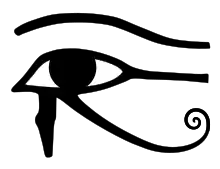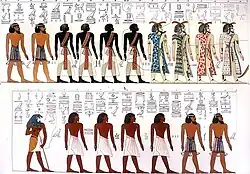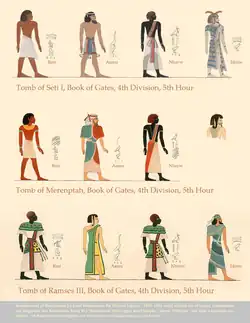| Part of a series on |
| Ancient Egyptian religion |
|---|
 |
|
|
The Book of Gates (Arabic: كتاب البوابات, romanized: Kitab al-Bawaabat) is an ancient Egyptian funerary text dating from the New Kingdom.[1] The text was not named by the Egyptians. It was named by French Egyptologist Gaston Maspero who called it 'Livre de Portes' (Book of Gates). The Book of Gates narrates the passage of a newly deceased soul into the next world, corresponding to the journey of the sun through the underworld during the hours of the night. The soul is required to pass through a series of 'gates' at different stages in the journey. Each gate is associated with a different goddess, and requires that the deceased recognize the particular character of that deity. Depictions of the judgment of the dead are shown in the last three hours and the text implies that some people will pass through unharmed, but that others will suffer torment in a lake of fire. The Book of Gates serves as a guidebook so that the deceased pharaoh with the sun god, can navigate his way to the afterworld and toward his resurrection. The Book of Gates is long and detailed and comprised of one hundred scenes. [2]
The text and images associated with the Book of Gates appear in many tombs of the New Kingdom, including all the pharaonic tombs between Horemheb (d.c. 1295 BC) and Ramesses VII (d.c. 1130 BC). They also appear in the tomb of Sennedjem, a worker in the village of Deir el-Medina, the ancient village of artists and craftsmen who built pharaonic tombs in the New Kingdom.
The goddesses listed in the Book of Gates each have different titles, and wear different coloured clothes, but are identical in all other respects, wearing a five pointed star above their heads. Most of the goddesses are specific to the Book of Gates, and do not appear elsewhere in Egyptian mythology, and so it has been suggested that the Book of Gates originated merely as a system for determining the time at night, with the goddess at each gate being a representation of the main star appearing during the hour.


The Fourth Division of the Fifth Hour
One of the most well known scenes in the Book of Gates is in it's fourth division section of the Fifth Hour. Gods are depicted in the upper row. They also carry the body of a serpent. Hieroglyphs meaning "lifetime" can be seen in in the lower register. At the beginning of the lower register are sixteen figures in repetitive sets of four. They are of the four ethnic groups who neighbored Egypt from various directions, they, the Egyptians, are at the front of the group and are followed in this sequence:
- Egyptians (Rmt)
- Asiatics (Aamu) (to the North)
- Nubians (Nehsey) (to the South)
- Libyans (Themehu) (to the West)
They are led by Horus and Sekhmet and likewise in Akhenaten's Great Hymn of Aten even these foreign people are assured transition to the afterworld. There has been ongoing controversy about variation in the depiction of this scene in different tombs. Looking at the facsimile illustration on the right entitled "Same scene depicted in 3 different tombs" (each row represents sixteen figures on the actual painting but since each type repeats four times, this is represented in the illustration as a single representative of each type) The hieroglyph order remains sequentially the same in all 3 tombs, left to right. Nubians are depicted in consistent ways in all three tombs although bare chested at the tomb of Seti I and the tomb of Merenptah but not at Ramesses III. Consistently however, all three Nubian (Nehesey) figures are beardless, have jet black skin and have a thick red sash that goes across the chest and also wraps around the waist and dangles down. However unlike in the tomb of Seti I and the tomb of Merenptah, at the tomb of Ramesses III, for unexplained reason, a second figure resembling this Nubian garbed type is also found in the first position usually occupied by Egyptians and with the corresponding hieroglyph usually representing Egyptians. These two virtually the same looking two figures at Ramesses III are similar in attire to Nubians such as those depicted in the Tomb of Huy but similar figures to these two are not found elsewhere in this same tomb of Ramesses III although many other typical Egyptian figures are. Another peculiarity is that Asiatic and Libyans are in consistent positions, 2nd and 4th respectively at Seti I and Merenptah but switch position at Ramesses III. At Seti I and Merenptah an Asiatic in the second position is depicted as a bearded figure with a cloth headband with two excess pieces hanging down, as is typical in much other art of the period. Also at these two tombs, Seti and Merenptah, a Libyan is at the end of the row, 4th position, and is depicted with typical Libyan features of the period, the side lock of hair and a long gown-like garment that is worn somewhat openly and with one or both shoulders exposed. However, while the hieroglyphs in all three tombs remain in the same position left to right, at Ramesses III, these two figures Asiatic and Libyan, have switched position, inexplicably. The only figure at Ramesses III that is in the same position as the figures at Seti I and Merenptah is the Nubian at position 3. The explanation remains unresolved. [3][4]
See also
References
- ↑ Hornung, Erik. The Ancient Egyptian Books of the Afterlife (in German). David Lorton (translator). Cornell University Press.
- ↑ Dunn, Jimmy. "The Book of Gates". touregypt.net. Retrieved December 2, 2023.
- ↑ Dunn, Jimmy. "The Book of Gates". touregypt.net. Retrieved December 2, 2023.
- ↑ Hornung, Erik. The Ancient Egyptian Books of the Afterlife (in German). David Lorton (translator). Cornell University Press.
Further reading
- Hornung, Erik; Abt, Theodor (editors): The Egyptian Book of Gates. Translated by Erik Hornung, in collaboration with Theodor Abt. Living Human Heritage Publications, Zurich 2014. ISBN 978-3-9523880-5-1
essay, "Witchcraft, Magic & Divination in Ancient Egypt", Borgouts, in Civilizations of the Ancient Near East, pgs. 1775+, ISBN 0-684-19722-7 (vol. 3)
External links
(Images, hieroglyphs, transcription and English translation).

._Bab_el_Meluk_(B%C3%AEb%C3%A2n_el-Mul%C3%BBk)._Grab_Sethos_I._(Plan_No._XVII)_a._d._Raum_D._(Forsetzung_von_Bl._135)%253B_c._Pfeiler_aus_Raum_J%253B_d._Ecke_aus_Raum_M._(c._und_d._(NYPL_b14291191-38309).jpg.webp)